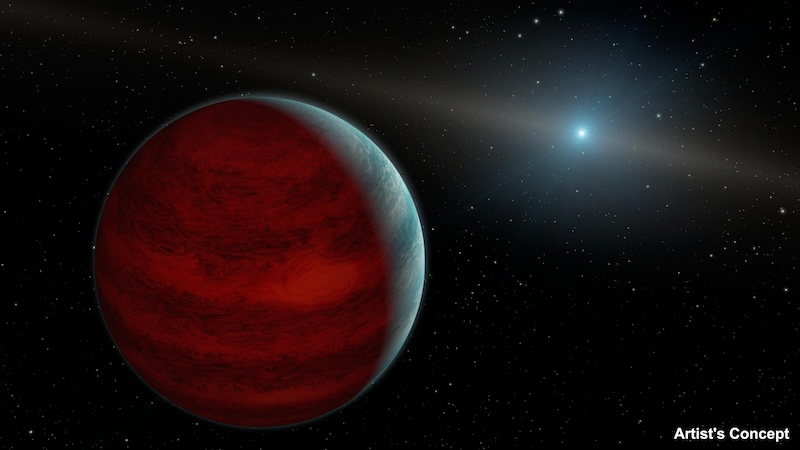Can a planet survive the death of its star? A new study says yes, it can. Scientists at the Space Telescope Science Institute (STScI) said in a new paper on January 24, 2023, that they have discovered two possible giant exoplanets orbiting white dwarfs, which are the remains of ordinary stars that have lost their ability to shine in the way most stars do. Both of these white dwarfs lie within 75 light-years of Earth. NASA’s James Webb Space Telescope first detected the planets in 2023. Astronomers have discovered planets orbiting white dwarf stars before, but, if confirmed, these will be the first planets around white dwarfs for which we have direct images.
Jonathan O’Callaghan wrote about the discovery for Science on January 31, 2024.
The researchers’ new peer-reviewed paper has been accepted for publication in The Astrophysical Journal Letters and is available on the arXiv preprint server.
Webb images 2 possible giant planets orbiting white dwarfs
Susan Mullally, an astronomer at the Space Telescope Science Institute, led the new observations. She and her colleagues used Webb to study four nearby white dwarfs, all of which are within 75 light-years of Earth. Two of those white dwarfs proved to be of particular interest, WD 1202-232 and WD 2105-82. Each of those white dwarfs appears to have a giant planet still orbiting it. In both cases, the planetary candidates orbit far out from their white dwarf stars, like the gas and ice giants in our solar system. Both white dwarfs are polluted with metals (heavy elements) in their atmospheres.
One of the planets is estimated to be 1.3 times as massive as Jupiter. Its orbit is similar to Saturn’s in our solar system. The other planet has a larger orbit, slightly farther from its white dwarf than Neptune is from our sun. That planet is also more massive, about 2.5 times that of Jupiter.
The discovery of these two giant worlds, if confirmed, shows that larger gas giant planets can indeed survive their stars becoming white dwarfs. Mullally said:
This is our first real indication that planets like Jupiter and Saturn should survive the evolution of their sun into a white dwarf.
The white dwarf planets are real … probably
Right now, the two planets are still considered to be candidates. They are not fully confirmed … yet. There is still a chance, albeit a small one, that they are false positives. They could actually be background galaxies, but the researchers said the chances of that are only about one in 3,000. To confirm the objects as real planets, the researchers need to make sure they are gravitationally bound to the stars. As Jay Farihi at University College London told Science:
You need to be sure they move together in space.
Only then can the researchers fully rule out background galaxies.
In addition, if the astronomers do confirm the planets, that would support the possibility that such planets could often survive their stars becoming white dwarfs. The research team was studying only four white dwarfs with Webb at the time. And two of those have planetary candidates. Mary Anne Limbach at the University of Michigan said:
Two out of their four systems have candidates, which is incredible. We’re going to be able to build up a sample of planets that look exactly analogous to Saturn and Jupiter in our system.

Other planets orbiting white dwarfs
Although these are the first exoplanet candidates to be directly imaged around white dwarfs, they are not the first detections.
In 2021, astronomers at the W. M. Keck Observatory in Hawaii said they found evidence of a gas giant planet orbiting a white dwarf 6,500 light-years away. The planet has a similar size and orbit to Jupiter in our solar system.
Astronomers reported another giant exoplanet around a white dwarf 1,500 light-years from Earth in 2019, too. This planet, however, seemed to be evaporating. That’s because it orbits very close to the white dwarf, completing an orbit in only 10 days.
Also, in 2021, astronomers found evidence of four white dwarfs consuming Earth-like planets. According to analysis of the vaporized material found, these are the remains of the outer layers, the crusts, of planets similar in rocky composition to Earth and Mars that used to orbit those stars.
1st habitable zone planet around a white dwarf
And in 2022, scientists said that there is likely a small rocky planet orbiting in the habitable zone of its white dwarf, 117 light-years away. Even though they are producing much less heat, white dwarfs can still have their own habitable zones, just like regular stars. It is in those zones that temperatures are suitable for a rocky planet to possibly have liquid water.
So it seems that planets around white dwarfs might be rather common. How do they compare to planets that orbit still-active stars? It will be interesting to see what telescopes like Webb and other reveal about them.
Bottom line: Astronomers using NASA’s Webb space telescope have discovered and imaged two possible giant planets orbiting white dwarfs. Both are less than 75 light-years away.
Source: JWST Directly Images Giant Planet Candidates Around Two Metal-Polluted White Dwarf Stars
Via Science
Read more: Solar system’s future seen: 1st planet around a white dwarf